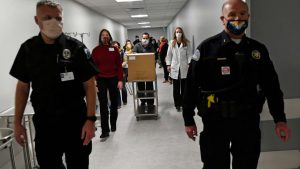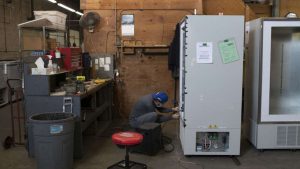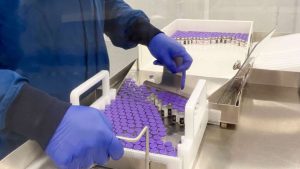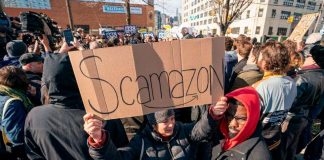DECEMBER 12, 2020

Officials and health workers at a hospital in Vail, Colo., rehearsed receiving a shipment of Covid vaccines last month. – Helen H. Richardson/MediaNews Group/The Denver Post, via Getty Images
At Novant Health in Winston-Salem, N.C., the new ultracold freezers are ready — enough to eventually house more than 500,000 doses of the first coronavirus vaccine approved in the United States.
In Los Angeles, the Cedars-Sinai medical center has installed extra security cameras to protect the secret location of its soon-to-arrive supply of the vaccine.
In Jackson, Miss., the state’s top two health officials are preparing to roll up their own sleeves in the coming days and be the first to get the shots there as cameras roll, hoping to send the message, “We trust it.”
The Food and Drug Administration’s emergency authorization on Friday night of the vaccine developed by Pfizer and BioNTech has set in motion the most ambitious vaccination campaign in the nation’s history, a challenge of staggering proportions choreographed against a backdrop of soaring infection rates and deaths. This weekend, 2.9 million doses of the vaccine are to begin traveling by plane and guarded truck from Pfizer facilities in Michigan and Wisconsin to designated locations, mostly hospitals, in all 50 states.

Ultralow-temperature freezers manufactured at a plant in Cincinnati. – Ty Wright/Bloomberg
The first injections are expected to be given by Monday to high-risk health care workers, the initial step toward the goal of inoculating enough Americans by spring to finally halt the spread of a virus that has killed nearly 300,000, sickened millions and upended the country’s economy, education system and daily life.
The rapid development of the vaccine, and its authorization based on data showing it to be 95 percent effective, has been a triumph of medical science, but much in this complicated next stage could go wrong.
The Pfizer vaccine needs to be kept at minus 94 degrees Fahrenheit, and the special boxes it is being shipped in can be opened no more than twice a day, in order to maintain the deep freeze. Side effects, like achiness or headache, could cause some of the nurses, doctors and others who are first in line for the vaccine to miss a day or two of work, challenging overburdened hospitals.

Vials of the Pfizer and BioNTech vaccine in a laboratory last month. – Pfizer/EPA, via Shutterstock
States say they have only a fraction of the funding they need from the federal government for staffing to administer the shot, for tracking who has received both doses of the vaccine — a booster is needed three weeks after the initial injection — and for other crucial pieces of the effort.
“Our teams are on standby, ready to pivot,” said Dr. Anne Zink, Alaska’s chief medical officer. Most of the state’s allocation will be delivered to a central location and then flown in small amounts, often in tiny planes, to far-flung hospitals and clinics that will need to quickly administer it.
Preparations for this moment have been months in the making. Military planners have looked at a range of potential obstacles, from large-scale protests that could disrupt traffic to poor weather conditions. In an emergency, officials are prepared to use military airplanes and helicopters to deliver vaccines to remote locations.
FedEx and UPS will transport the vaccine throughout most of the country, and each delivery will be followed by shipments of extra dry ice a day later. Pfizer designed special containers, with trackers and enough dry ice to keep the doses sufficiently cold for up to 10 days. Every truck carrying the containers will have a device that tracks its location, temperature, light exposure and motion.
For all the planning, and contingencies, there is still a good deal of confusion. States are receiving initial allocations according to a federal formula based strictly on their adult population. But many hospitals say they still don’t know exactly how much they will get or when the shipments will arrive.
“It’s really been a lot of the unknowns about the logistics,” said Dr. Jeffrey A. Smith, the chief operating officer for Cedars-Sinai, noting that the medical center was also treating the highest number of Covid-19 patients it had seen since the pandemic began in March.
Other hospital systems are reeling from the news that their initial allocations will be much smaller than they had hoped. The Cleveland Clinic, one of the 10 hospital groups in Ohio that are receiving the first batch of vaccines, is expecting only 975 doses in an initial shipment, even though it has more than 40,000 employees around the state.
Ohio has prioritized getting initial doses of the vaccine to people in nursing homes and assisted living centers because they are at such high risk.
“We’re going to have a lot less vaccine than we have people wanting it,” Dr. Robert Wyllie, Cleveland Clinic’s chief of medical operations, said, adding that the system would first vaccinate workers in the intensive care units
Everybody who works in those units, including housekeepers, will be eligible for a shot. Like many health systems, Cleveland Clinic plans to stagger vaccinations so that if side effects cause some employees to miss work, the unit can still be fully staffed.
One reason for the shortfall in initial supply is that federal officials recently decided to send out a little fewer than half of the 6.4 million doses they had initially planned for the first wave.
On a call with reporters Wednesday, Gen. Gustave F. Perna, the chief operating officer for Operation Warp Speed, said he was taking a cautious approach to doling out the vaccine, setting aside for subsequent shipments another 2.9 million doses for booster shots, which are given three weeks later, as well as an emergency reserve supply.
But that careful strategy has come under criticism from others, who have argued that the vaccine must be deployed as quickly as possible, given that infections are raging out of control, hospitals are overflowing and thousands of people are dying a day. The F.D.A. released data this week showing that Pfizer’s vaccine begins to offer some protection from the coronavirus even before people get their second doses.
“We know the first dose is partially protective,” Dr. Scott Gottlieb, a former F.D.A. commissioner and a board member of Pfizer, said on CNBC Friday. “We need to get as much protective immunity as possible into the general public.”
Pfizer has said it can provide up to 25 million doses to the U.S. by the end of this month. “Eventually, we will become much more confident in our manufacturing, our distribution process, state handling, et cetera,” General Perna said. “And then the requirement for reserve won’t be necessary.”
Additional vaccines are in the pipeline. Moderna recently applied for emergency authorization for its vaccine. The company said it is “on track” to produce 20 million doses by the end of this month and between 500 million and a billion through 2021.
States are largely planning to follow recommendations from the Centers for Disease Control and Prevention about who gets vaccinated first: health care workers at high risk of exposure to Covid-19 and residents of nursing homes and other long-term-care facilities, a population that has died from the virus at disproportionately high rates.
There is some variation among their plans. Gov. Ron DeSantis of Florida said this week that “tip-of-the-spear, high-contact workers” in hospitals would receive the very first shots and that he hoped to reach “as many elderly people as we can” by the end of December.
In Mississippi, Dr. Thomas Dobbs, the state health officer, said frontline hospital workers would get the shots ahead of nursing home residents, in part to ease any anxiety those residents might have about the vaccine.
“They’re still a little bit hesitant,” he told reporters on Tuesday. “If we don’t put ourselves out there first, take the first doses of vaccine and show that we believe in it and trust it, I don’t think the long-term-care folks are going to have the uptake they need.”
In most states, the concerted effort to vaccinate nursing home residents will begin a week later. Starting Dec. 21, CVS and Walgreens will send teams of pharmacists out to about 75,000 nursing homes and other long-term-care facilities in all 50 states, under a contract with the federal government, to vaccinate as many residents and staff members as agree to it. CVS is aiming to complete the process over nine to 12 weeks.
On Thursday afternoon, as an F.D.A. advisory committee debated whether to recommend authorization of the Pfizer vaccine, the first packages of supplies to administer it — vaccination record cards, masks, visors, information sheets and syringes — arrived at UPMC Presbyterian, a hospital in Pittsburgh.
Dr. Graham Snyder, the medical director of infection prevention and hospital epidemiology at UPMC, said that a hospital committee had concluded that the immediate goal for allocation was to prevent transmission from the community to the hospital staff.
“The greater likelihood of their exposure is in the community and home than in the workplace,” he said, noting that health care workers have generally taken great precautions when they are among patients.
Some hospitals have said they will give priority to workers with underlying medical conditions that would put them at higher risk for severe disease.
Dr. Marci Drees, the infection prevention officer and hospital epidemiologist at ChristianaCare, a Delaware-based hospital system, said that the system would offer its health care workers a list of such conditions but would ask them only to disclose generally whether they had any.
“Lower-wage workers might be less likely to disclose because of the perception of discrimination,” Dr. Drees said. “So we’re trying to focus on job roles and spreading allocation across our system.”
One of the biggest outstanding questions is how many Americans — even in the health care field — will hesitate to get the vaccine; a Pew Research Center poll conducted late last month found that 18 percent said that they would “definitely not” take the vaccine “if it were available today” and that 21 percent said that they would “probably not.”
Many health care workers have been hesitant about this vaccine because it is so new, and they are eager to see hard data before they decide whether to take it. Mindful of their cautiousness, Dr. Drees said that ChristianaCare was emphasizing to its staff that taking the vaccine is voluntary.
“While I know that the risk of getting Covid far outweighs the risk of getting the vaccine,” Dr. Drees said, “meeting workers where they are at is important.”
At Spartanburg Regional Healthcare System in South Carolina, Dr. Chris Lombardozzi, the system’s chief medical officer, said he did not anticipate much in the way of resistance from employees. “Our medical staff is completely on board,” he said, noting that he’d had discussions with leaders of several departments. To a person, he said, they say, “I want to be first.”
Their willingness reflects the reality of how hard the pandemic has hit their professions.
“We are so tired of this,” Dr. Lombardozzi said. “We are tired of watching people die. We are tired of not having a cure for an awful, awful virus. We want this to go away.”
Courtesy/Source: NY Times











































































































